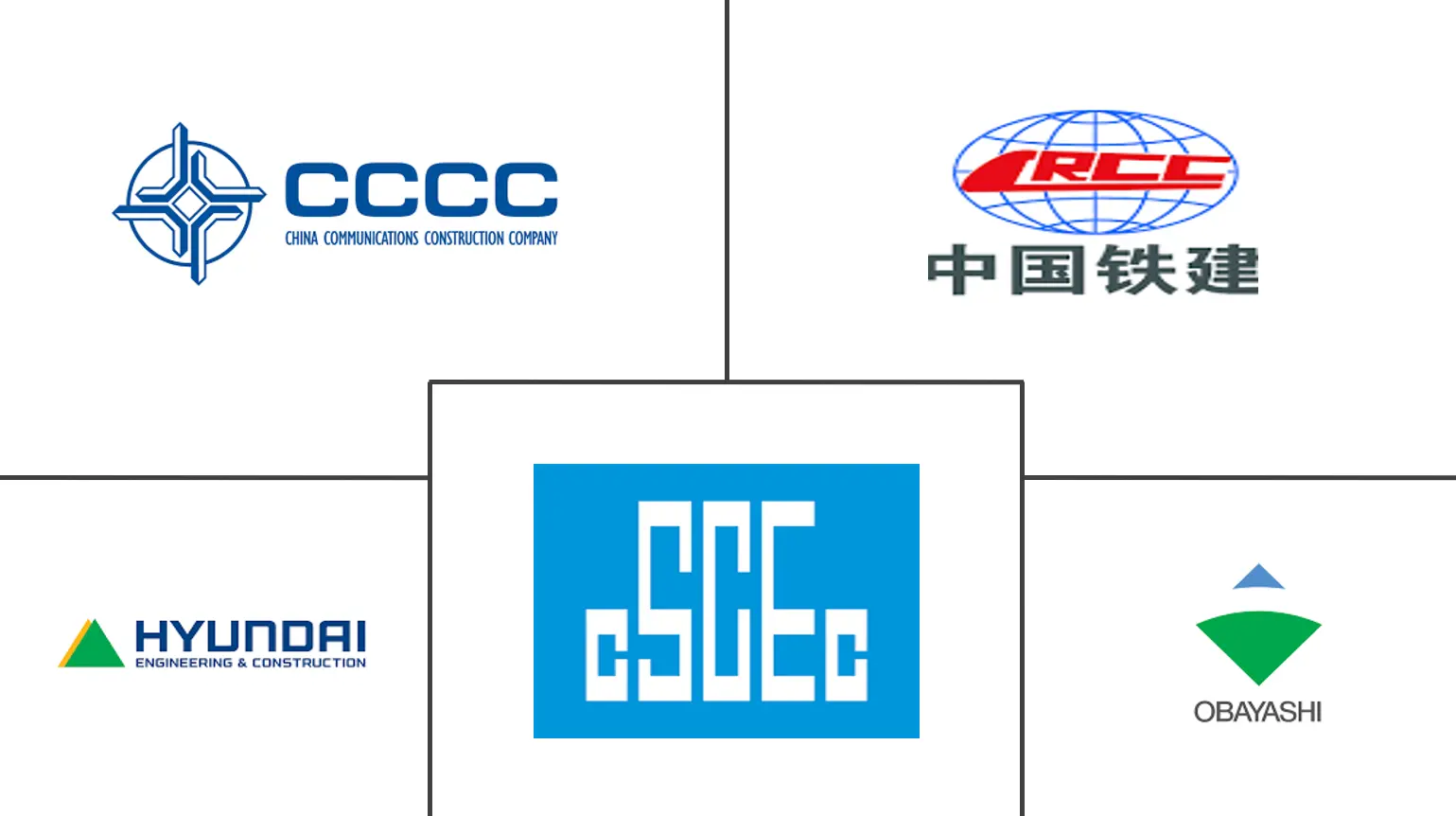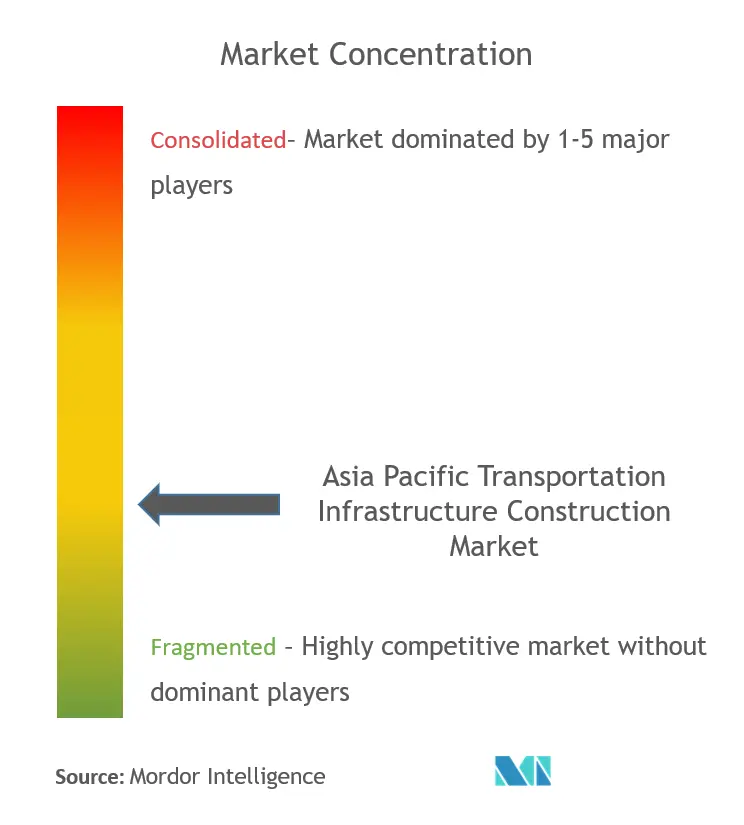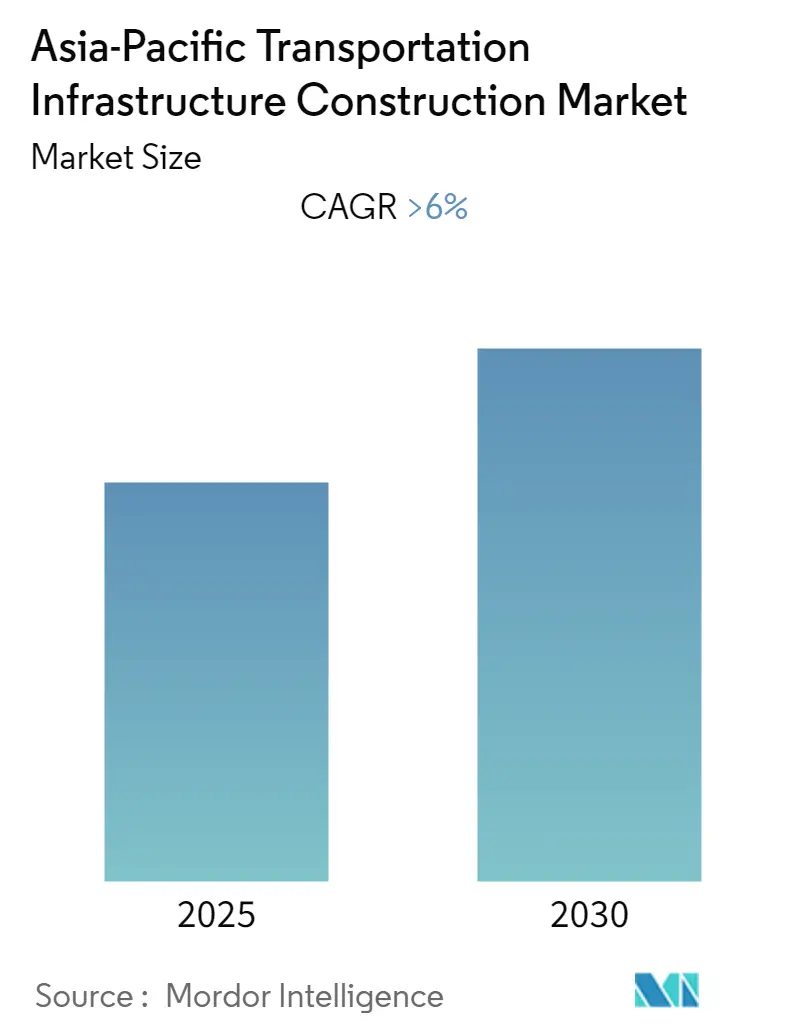
Asia-Pacific Transportation Infrastructure Construction Market Analysis
The Asia-Pacific Transportation Infrastructure Construction Market is expected to register a CAGR of greater than 6% during the forecast period.
- Every year, approximately 44 million people are added to Asia's urban population, which equates to 120,000 people per day. In Asian cities, public transportation is the primary mode of transportation. Construction of urban roads alone is not the solution because it encourages a downward spiral of increased purchases and use of private vehicles, resulting in even more congestion. Infrastructure spending may be the most effective way for governments to stimulate their ailing economies. This is because, first and foremost, infrastructure development has a powerful multiplier effect in terms of increasing economic activity and job creation. This means that the overall impact on economic output is greater than the initial spending injection. Second, infrastructure investment is critical for leaving a positive economic legacy of more resilient, sustainable, and productive growth.
- Singapore has anticipated future transportation challenges with a growing population and over 14 million journeys per day and has planned to ensure that the small city-state meets the needs of the population and that the infrastructure is fit for purpose through innovative use of technology and policy decisions. With this in mind, the Land Transport Authority (LTA) is evaluating solutions to build a transportation system capable of dealing with future challenges as well as developing new solutions to improve the current system. The Land Transport Authority (LTA) Master Plan (LTMP) 2040 report summarizes the LTA's long-term plans to construct an efficient, well-connected, inclusive, and fast land transportation system that will meet Singaporeans' needs and aspirations over the next two decades and beyond. Singapore's ambitious metro expansion continues to provide choice contracts for domestic firms and foreign ones with track records in the city-state.
- Logistics is a critical component of India's economic development. Despite its low ranking, India has an advantage in that the majority of its infrastructure network capacity is being built. The logistics sector has seen rapid growth in recent years, which slowed since COVID-19. The Indian government is investing in the development of dedicated rail freight corridors, which will allow freight trains to run on exclusive tracks. The dedicated freight corridors will eventually lower the cost of moving cargo by utilizing larger capacity electric-powered trains. Overall, the government's recent actions and policies appear to be promising for the sector's development.
- China is showing off its transportation skills by building more highways, trains, waterways, and airports in China, Central Asia, and Europe. The Belt and Road Initiative is divided into two parts: a land route connecting China with Southeast Asia, South Asia, Central Asia, Russia, and Europe; and a sea route connecting China's coastal regions with Southeast and South Asia, the South Pacific, the Middle East, and Eastern Africa all the way to Europe. A more convenient logistics network is also under construction. According to Li and Dai, parcels will be delivered to customers in China in one day, to neighboring countries in two days, and to major cities around the world in three days-at least according to plans drawn up by the Ministry of Transportation.
Asia-Pacific Transportation Infrastructure Construction Market Trends
Government initiatives driving transport infrastructure market in India
- According to a government report, the road transport and highways sector has the most delayed projects (243), then railways (114), and then petroleum (89).243 of 826 projects are behind schedule in the road transport and highways sector. According to the most recent flash report on infrastructure projects for October 2022, 114 out of 173 projects in the railway sector has been delayed, while 89 out of 142 projects in the petroleum sector have been delayed. As many as 642 projects have been delayed from their original schedules, and 79 projects have reported additional delays from their previous month's completion date. 32 of these 79 projects have a cost of Rs 1,000 crore (USD 12.11 million) or more.
- India wants to have a $5 trillion economy by 2025, and building up its infrastructure is a key part of that plan. To boost the growth of the infrastructure sector, the government has launched the National Infrastructure Pipeline (NIP), in conjunction with other initiatives such as 'Make in India' and the production-linked incentives (PLI) scheme. Historically, more than 80% of infrastructure spending in the United States has gone toward transportation, electricity, water, and irrigation. In India, approximately 42% of the NIP projects are currently being implemented, implying that construction work is already underway. Another 19% are in the development stage, with a sizable 31% still in the conceptual stage. During the fiscal years 2020 to 2025, sectors such as energy (24%), roads (19%), urban (16%), and railways (13% each) will account for around 70% of the projected capital expenditure on infrastructure in India.
- The Delhi-Mumbai Industrial Corridor (DMIC) is the first project by the Indian government to build an industrial corridor. The organization in charge of carrying out the project, the Delhi-Mumbai Industrial Corridor Development Corporation (DMICDC), was set up in 2008. The total amount sanctioned for this program is approximately $2.4 billion. The program has taken on 11 industrial corridor projects, and a total of 30 projects will be developed in four phases by 2024-25. The National Industrial Corridor Development and Implementation Trust (NICDIT) works under the administrative control of the Department of Promotion of Industry and Internal Trade (DPIIT) to coordinate and integrate the development of all industrial corridors in various stages of development.
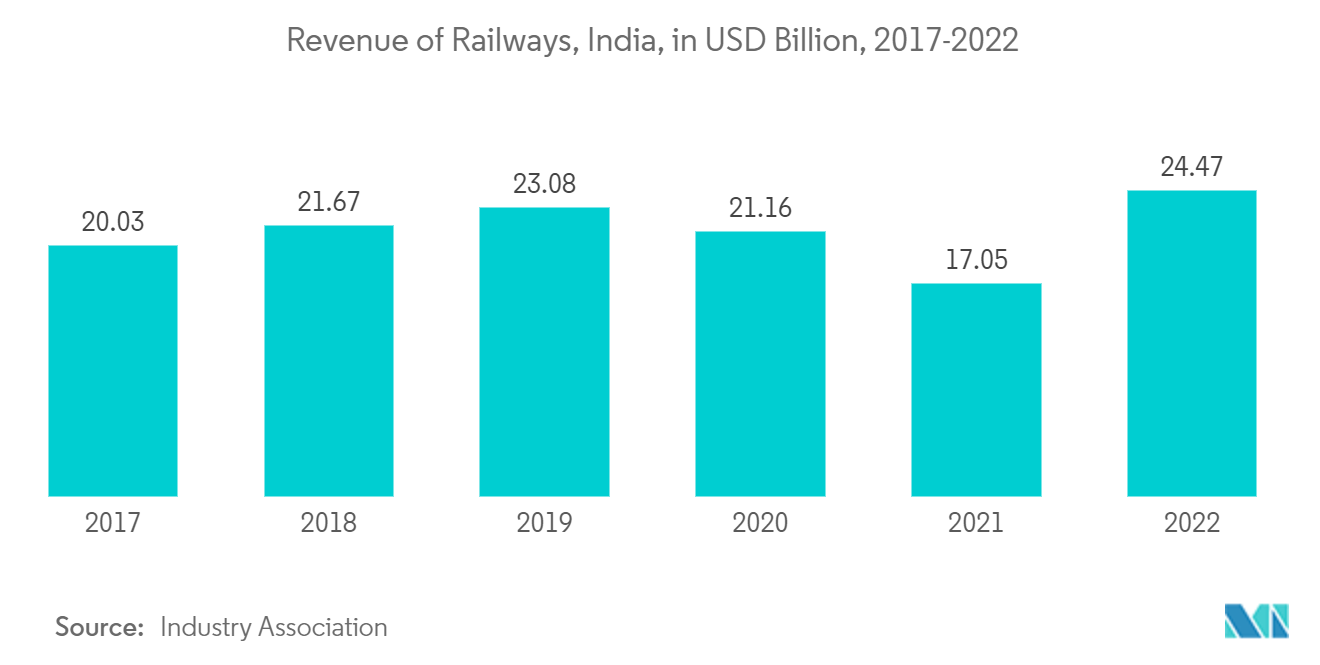
Boosting logistics sector and urban transportation driving the market
- Shippers are lowering operational costs by shifting their attention away from transportation and back-office functions. Because of the growing public-private partnership model and increased emphasis on logistics infrastructure, the roadways segment will account for the largest share in 2021. Over the forecast period, globalization and sustainable economic growth are expected to drive the growth of the airway's logistics mode. A sharp slowdown in global economic growth will weigh on the global construction industry in 2. This year is expected to be marked by low industry sentiment, low project activity levels, and postponement of investment decisions. In 2023, an increased emphasis on energy security will emerge as an increasingly important driver of global infrastructure investment.
- Asia and the Pacific are undergoing rapid demographic, technological, economic, and environmental transformations. These trends are intersecting with local circumstances in a highly diverse region, ranging from major industrial economies like the People's Republic of China to Pacific nations like Kiribati. The megatrends influencing transportation in the region are fairly obvious. However, their impact and relative priority will vary depending on location and context. Climate change will be the most important trend to consider for many countries. The appropriate policy and investment decision in response to a trend is determined by factors such as geography, existing infrastructure, institutional capacity, and the overall investment pipeline.
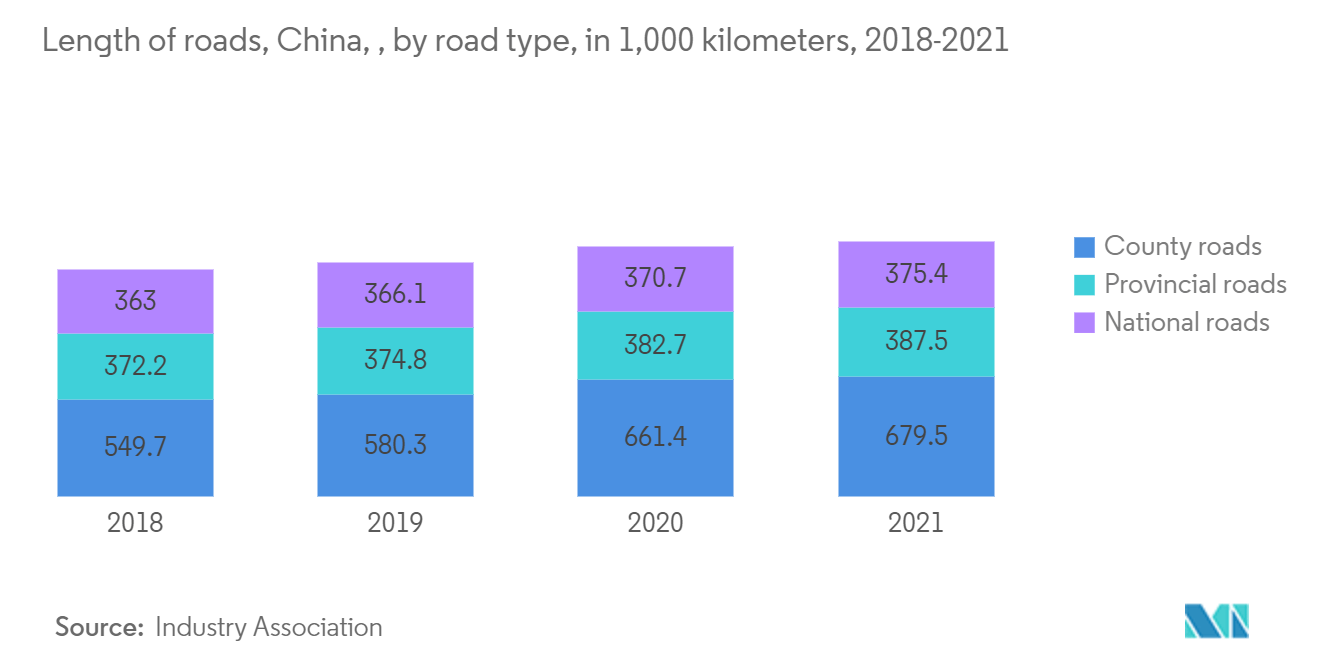
Asia-Pacific Transportation Infrastructure Construction Industry Overview
The Asia Pacific transportation infrastructure construction market is relatively fragmented, with a large number of local and regional players and a few global players. The major players include China State Construction Engineering Corporation Ltd., China Railway Construction Corporation, China Communications Construction Company Ltd., Hyundai Engineering & Construction, OBAYASHI CORPORATION, and many others. There are many new projects upcoming in the sector, increasing public-private partnerships in the market to explore opportunities. This has created opportunities for the global players to invest in the market, as they have world-class facilities to deliver in it.
Asia-Pacific Transportation Infrastructure Construction Market Leaders
-
China State Construction Engineering Corporation Ltd.
-
China Railway Construction Corporation
-
China Communications construction company Ltd.
-
Hyundai Engineering & Construction
-
OBAYASHI CORPORATION
- *Disclaimer: Major Players sorted in no particular order
Asia-Pacific Transportation Infrastructure Construction Market News
- January 2023: The Indo-Japan Joint Working Group (JWG) will work together to provide the best road infrastructure for commuters and freight movement while also assisting India in meeting its sustainable transportation goals. The collaborative projects will lead to a massive digital transformation in the areas of intelligent transportation systems (ITS) and environmentally friendly mobility. India's strong commitment to collaboration with Japan in the areas of highway development, administration, and monitoring through the implementation of digitally enabled ITS services
- January 2023: China's CRRC Corporation Ltd. Green trains were first introduced in Germany a few months ago, the first hydrogen urban train in Asia and the second in the world. The hydrogen trains travel at 160 km/h and have a range of 600 km without refuelling. The CRRC will also provide digital solutions, such as GoA2 automation, component monitoring sensors, and 5G data transmission equipment, to the train. The train operation is expected to reduce CO2 emissions by 10 tons per year compared to diesel traction.
Asia-Pacific Transportation Infrastructure Construction Industry Segmentation
Transportation infrastructure is the system of public works that makes it easier for people to move around.Roads, railways, ports, and airports are all part of it. A complete background analysis of the Asia Pacific Transportation Infrastructure Construction Market, including the assessment of the economy and contribution of sectors in the economy, a market overview, market size estimation for key segments, emerging trends in the market segments, market dynamics and geographical trends, and COVID-19 impact, is covered in the report.
The Asia Pacific Transportation Infrastructure Construction Market is segmented by mode (roads, railways, airways, and waterways) and country (China, India, Vietnam, Japan, South Korea, Indonesia, Thailand, and the Rest of Asia-Pacific). The report offers market size and forecast values (in USD) for all the above segments.
| By Modes | Roads |
| Railways | |
| Airways | |
| Waterways | |
| By Country | China |
| India | |
| Vietnam | |
| Japan | |
| South Korea | |
| Indonesia | |
| Thailand | |
| Rest of Asia-Pacific |
Asia-Pacific Transportation Infrastructure Construction Market Research FAQs
What is the current Asia-Pacific Transportation Infrastructure Construction Market size?
The Asia-Pacific Transportation Infrastructure Construction Market is projected to register a CAGR of greater than 6% during the forecast period (2025-2030)
Who are the key players in Asia-Pacific Transportation Infrastructure Construction Market?
China State Construction Engineering Corporation Ltd., China Railway Construction Corporation, China Communications construction company Ltd., Hyundai Engineering & Construction and OBAYASHI CORPORATION are the major companies operating in the Asia-Pacific Transportation Infrastructure Construction Market.
What years does this Asia-Pacific Transportation Infrastructure Construction Market cover?
The report covers the Asia-Pacific Transportation Infrastructure Construction Market historical market size for years: 2019, 2020, 2021, 2022, 2023 and 2024. The report also forecasts the Asia-Pacific Transportation Infrastructure Construction Market size for years: 2025, 2026, 2027, 2028, 2029 and 2030.
Our Best Selling Reports
Asia-Pacific Transportation Infrastructure Construction Industry Report
Statistics for the 2025 Asia-Pacific Transportation Infrastructure Construction market share, size and revenue growth rate, created by Mordor Intelligence™ Industry Reports. Asia-Pacific Transportation Infrastructure Construction analysis includes a market forecast outlook for 2025 to 2030 and historical overview. Get a sample of this industry analysis as a free report PDF download.

